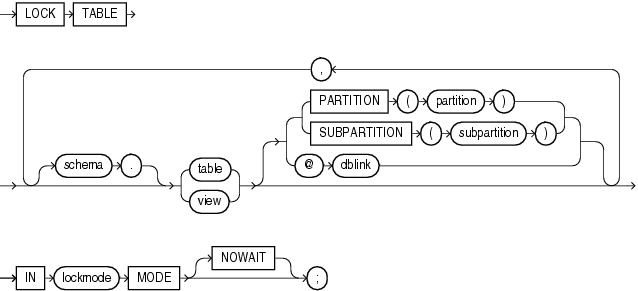| Oracle® Database SQL Reference 10g Release 2 (10.2) Part Number B14200-02 |
|
|
View PDF |
| Oracle® Database SQL Reference 10g Release 2 (10.2) Part Number B14200-02 |
|
|
View PDF |
Purpose
Use the LOCK TABLE statement to lock one or more tables, table partitions, or table subpartitions in a specified mode. This lock manually overrides automatic locking and permits or denies access to a table or view by other users for the duration of your operation.
Some forms of locks can be placed on the same table at the same time. Other locks allow only one lock for a table.
A locked table remains locked until you either commit your transaction or roll it back, either entirely or to a savepoint before you locked the table.
A lock never prevents other users from querying the table. A query never places a lock on a table. Readers never block writers and writers never block readers.
Prerequisites
The table or view must be in your own schema or you must have the LOCK ANY TABLE system privilege, or you must have any object privilege on the table or view.
Syntax
lock_table::=

Semantics
schema
Specify the schema containing the table or view. If you omit schema, then Oracle Database assumes the table or view is in your own schema.
Specify the name of the table or view to be locked.
If you specify view, then Oracle Database locks the base tables of the view.
If you specify PARTITION or SUBPARTITION, then Oracle Database first acquires an implicit lock on the table. The table lock is the same as the lock you specify for partition or subpartition, with two exceptions:
If you specify a SHARE lock for the subpartition, then the database acquires an implicit ROW SHARE lock on the table.
If you specify an EXCLUSIVE lock for the subpartition, then the database acquires an implicit ROW EXCLUSIVE lock on the table.
If you specify PARTITION and table is composite-partitioned, then the database acquires locks on all the subpartitions of partition.
Restriction on Locking Tables If view is part of a hierarchy, then it must be the root of the hierarchy.
Specify a database link to a remote Oracle Database where the table or view is located. You can lock tables and views on a remote database only if you are using Oracle distributed functionality. All tables locked by a LOCK TABLE statement must be on the same database.
If you omit dblink, then Oracle Database assumes the table or view is on the local database.
Specify one of the following modes:
ROW SHARE ROW SHARE permits concurrent access to the locked table but prohibits users from locking the entire table for exclusive access. ROW SHARE is synonymous with SHARE UPDATE, which is included for compatibility with earlier versions of Oracle Database.
ROW EXCLUSIVE ROW EXCLUSIVE is the same as ROW SHARE, but it also prohibits locking in SHARE mode. ROW EXCLUSIVE locks are automatically obtained when updating, inserting, or deleting.
SHARE SHARE permits concurrent queries but prohibits updates to the locked table.
SHARE ROW EXCLUSIVE SHARE ROW EXCLUSIVE is used to look at a whole table and to allow others to look at rows in the table but to prohibit others from locking the table in SHARE mode or from updating rows.
EXCLUSIVE EXCLUSIVE permits queries on the locked table but prohibits any other activity on it.
Specify NOWAIT if you want the database to return control to you immediately if the specified table, partition, or table subpartition is already locked by another user. In this case, the database returns a message indicating that the table, partition, or subpartition is already locked by another user.
If you omit this clause, then the database waits until the table is available, locks it, and returns control to you.
Examples
Locking a Table: Example The following statement locks the employees table in exclusive mode but does not wait if another user already has locked the table:
LOCK TABLE employees IN EXCLUSIVE MODE NOWAIT;
The following statement locks the remote employees table that is accessible through the database link remote:
LOCK TABLE employees@remote IN SHARE MODE;